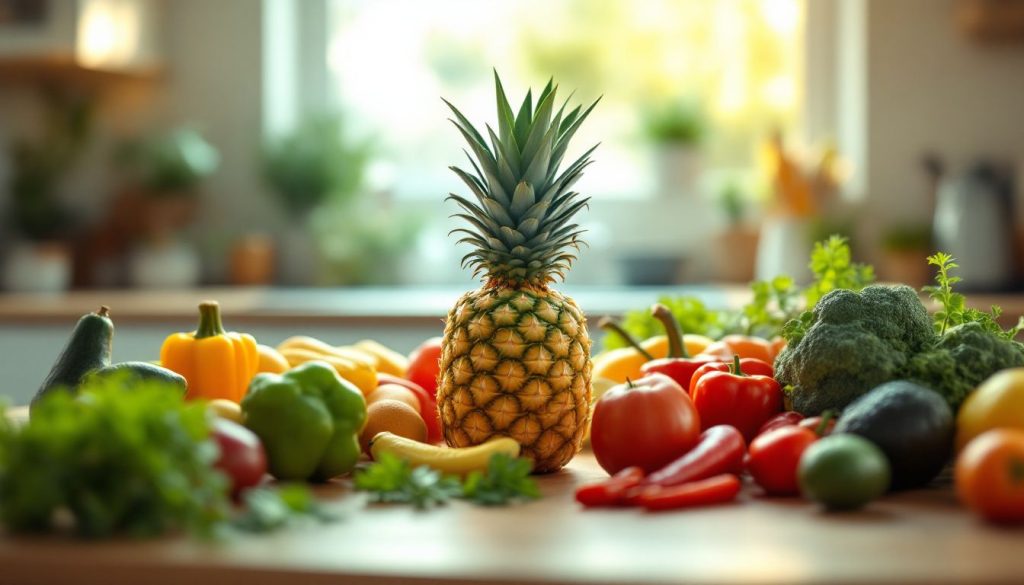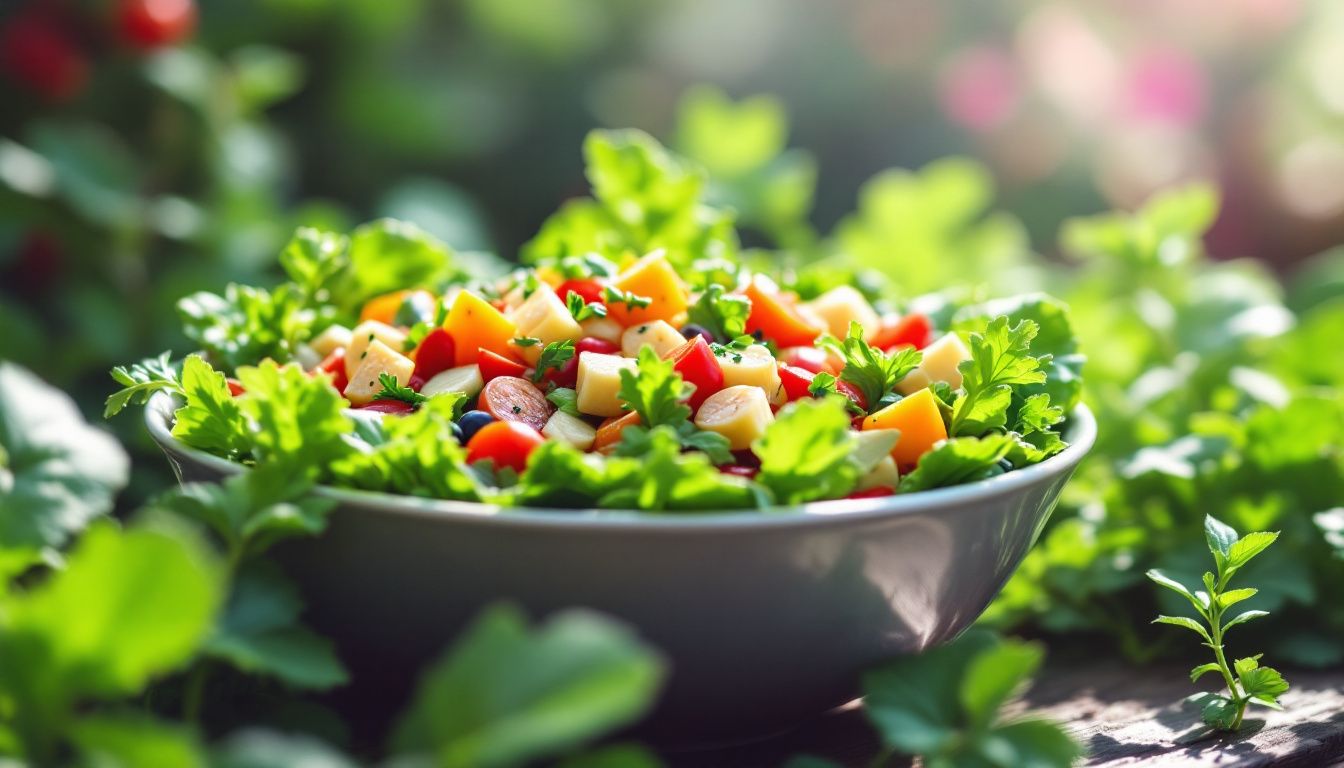Many people eat too much red meat, which can harm their health and the planet. Studies show that cutting back on red meat lowers the risk of heart disease and type 2 diabetes. This blog will share tips for eating more greens and reducing meat consumption without sacrificing taste or nutrients.
Thank you for reading this post, don't forget to subscribe!Keep reading—it’s easier than you think!
Key Takeaways
- Eating less red meat lowers the risk of heart disease, strokes, and type 2 diabetes. Cutting animal protein by just 3% reduces early death chances by 19%.
- Reducing red meat helps the planet. Livestock farming causes deforestation, pollution, and greenhouse gas emissions that worsen climate change.
- Plant-based diets offer fiber, vitamins like C and folic acid, and minerals for good health. Pairing plant proteins like beans with rice ensures all essential amino acids.
- Switching to greens supports digestion and gut health. Probiotic foods like sauerkraut or miso improve nutrient absorption while feeding healthy gut bacteria.
- Simple swaps—like lentils in tacos or veggie burgers—make meals healthier without sacrificing taste. These changes cut saturated fats and help protect your heart!
Why Reduce Red Meat Consumption?
Eating too much red meat can harm your health. It also hurts the planet through pollution and resource use.
Health benefits of reducing red meat
Eating less red meat lowers the risk of heart disease, strokes, and diabetes. Red meats like bacon and pork are high in saturated fats. These fats raise bad cholesterol levels, making your heart work harder.
Processed meats also release toxins that harm blood vessels and organs. Studies show cutting animal proteins by just 3% reduces the odds of early death by 19%.
Plant-based diets improve overall health. They reduce risks tied to high blood pressure and chronic illnesses linked to an unhealthy diet. Foods rich in fiber from plant sources help control BMI while boosting digestion.
Green-based meals promote good cholesterol production, improving human nutrition without sacrificing essential nutrients.
A diet with more plants creates a path to better health.
Environmental impact of red meat production
Red meat production harms the environment. Livestock farming releases large amounts of greenhouse gases like methane and carbon dioxide, which worsen climate change. Farming animals uses huge amounts of water for drinking and growing animal feed.
It also leads to deforestation, especially in places like the Amazon rainforest, where trees are cleared to make room for grazing or crop farming for livestock feed.
Farming animals often results in air and water pollution. Manure runoff from farms pollutes rivers, creating dead zones where no fish or plants can survive. Excessive consumption of red meat increases the demand for unsustainable agricultural practices, leading to loss of biodiversity and soil degradation.
Food waste from animal production adds more emissions into the food system, making it harder to achieve sustainable development goals.

The Benefits of Eating More Greens
Eating more greens can uplift your health in many ways. They are loaded with nutrients that support the body and keep you feeling great daily.
Nutritional advantages of plant-based foods
Plant-based foods provide high levels of fiber, vitamins, and minerals. Whole grains, leafy greens, and legumes are rich in essential nutrients like folic acid and vitamin C. These help maintain healthy digestion and support the immune system.
Studies published in *JAMA Internal Medicine* show lower body mass indexes (BMI) linked to plant-based diets.
Proteins from plants can meet daily nutritional needs when combined wisely. A mix of beans, lentils, nuts, or seeds ensures complete amino acids for optimal health. Experts report a reduced risk of heart disease and diabetes among those who focus on plant-based options over red meat…
leading to better overall well-being!
Improved digestion and gut health
High-fiber foods like whole grains, beans, and vegetables boost digestion. Fiber reduces gut inflammation and supports regular bowel movements. Foods rich in polyphenols, such as spinach and berries, also feed good bacteria in the gut.
Probiotics found in yogurt, sauerkraut, and miso promote a healthy balance of gut bacteria. This balance improves nutrient absorption and enhances mood through gut-brain interaction.
A diet filled with greens helps maintain human health while lowering risks linked to digestive issues.
Lower risk of chronic diseases
Eating more greens can lower the risk of chronic diseases, like heart disease and diabetes. Plant-based foods are full of vitamins, minerals, and antioxidants that help protect your body.
For example, fruits and vegetables support metabolic regulation by fighting harmful oxidative stress. They also improve cardiovascular health by reducing total cholesterol levels naturally.
Diets rich in plants are linked to fewer non-communicable diseases (NCDs). Unlike red meat, plant-based proteins have none of the saturated fats tied to serious health risks. Cutting down on salt-heavy animal products like processed meats also helps reduce high blood pressure—a major cause of strokes and heart attacks.
Exploring Plant-Based Alternatives
Plant-based choices can make your meals more exciting and healthy. Try new ingredients and flavors to create satisfying dishes without meat!
Incorporate more vegetables into meals
Adding more vegetables to meals is simple and rewarding. They bring flavor, nutrients, and help create a sustainable food system.
- Use leafy greens like spinach or kale in pasta dishes. These add vitamins and minerals without overpowering the meal.
- Roast carrots, zucchini, or sweet potatoes as side dishes. Roasting enhances their natural sweetness and avoids food waste.
- Replace meat fillings with beans or lentils in tacos. This supports healthy eating and reduces reliance on livestock production.
- Blend steamed broccoli or cauliflower into soups for a creamy texture without heavy cream. It improves digestion while keeping the meal light.
- Add shredded cabbage or lettuce to sandwiches and wraps for crunch and fiber, boosting food sustainability in your diet choices.
- Mix diced peppers, mushrooms, or tomatoes into scrambled eggs for breakfast variety rich in antioxidants.
- Swap meat toppings on pizza with grilled eggplant or spicy chicken alternatives made from soy—a tasty twist on traditional meals.
- Stir fry broccoli, snow peas, or bok choy with tofu for balanced nutrition that lowers greenhouse gas emissions linked to red-meat consumption.
- Sneak grated zucchini into baked goods like muffins or bread for extra moisture and hidden vegetable benefits.
- Serve salads alongside main courses using fresh ingredients such as cucumbers, cherry tomatoes, and whole grains for a complete dish.
Swap red meat for plant-based proteins
Switching red meat with plant-based proteins can improve your health and help the planet. Plant-based foods provide nutrients without environmental damage caused by livestock production.
- Replace beef or pork with beans, lentils, or peas. They are rich in protein and fiber, keeping you full longer.
- Try edamame or tofu as a substitute. Both are high in protein and low in fat.
- Use nuts and seeds like almonds, chia seeds, or sunflower seeds to add protein to meals.
- Choose whole grains such as quinoa or farro for added nutrition and variety.
- Experiment with veggie burgers made from black beans or chickpeas for lunch options.
- Prepare dishes using mushrooms, which have a meaty texture and deep flavor.
- Add jackfruit to recipes—it works well as a replacement for pulled pork or chicken.
- Consider margarine made from plants instead of animal fats for spreads or cooking.
Exploring plant-based alternatives opens up delicious ways to enjoy more greens daily!

Experiment with meatless recipes
Trying meatless recipes can make eating healthy easier and more fun. They are great for adding variety to your meals while reducing red meat.
- Cook “Easy Spiced Lentil Tacos.” Use simple ingredients like red lentils, olive oil, onion, garlic, and taco seasoning. This dish is flavorful and packed with plant-based protein.
- Make your own taco seasoning. Mix 3 tablespoons chili powder, 3 tablespoons cumin, 1 teaspoon garlic powder, 1/2 teaspoon black pepper, 1/2 teaspoon salt, and 1/4 teaspoon cayenne pepper.
- Try plant-based alternatives like tofu or tempeh. These mimic the texture of meat and absorb flavors well in stir-fries or marinades.
- Bake a veggie-based burger using black beans or mushrooms. Both offer a hearty texture and are rich in nutrients.
- Swap ground beef with lentils in spaghetti sauce or chili dishes. It lowers saturated fat while keeping the meal filling.
- Roast vegetables like cauliflower or eggplant for steaks on the grill. They pair well with bold seasonings for added flavor.
- Add chickpeas to salads or sandwiches for extra protein and crunch without animal products.
- Blend cashews into creamy sauces as dairy replacements for pasta dishes or soups—healthy yet satisfying!
- Experiment once per week with a new recipe—it could be an easy curry, soup, or stew made entirely from plants.
- Look into pre-made options at the grocery store if short on time—there are many plant-based burgers available now that taste just as good as traditional ones!
Common Challenges and How to Overcome Them
Many worry about getting enough protein or planning meals with less meat—but simple solutions can make the change easier.
Addressing protein concerns
Protein needs can be met without red meat. Beans, lentils, chickpeas, and soy provide plant-based proteins rich in essential amino acids. Pairing foods like rice and beans ensures a complete amino acid profile.
Eating nuts, seeds, or quinoa adds variety while boosting protein intake.
Emerging sources like algae offer new options for sustainable diets. Studies show that plant proteins support muscle health and meet dietary requirements effectively. Foods such as tofu and tempeh are easy swaps for meat in meals.
These choices reduce greenhouse gas emissions tied to intensive livestock production and promote better human health.
Managing meal preparation and planning
Stock your pantry with healthy foods from all five food groups. Include staples like whole grains, legumes, and frozen fruits or vegetables. These make meal prep easier and save time on busy days.
Frozen produce keeps its vitamins while lasting longer than fresh options.
Set a specific day for cooking larger meals to plan ahead. This helps create leftovers that store safely for future use, reducing food waste. Keep family schedules in mind when creating menus to match everyone’s needs.
A little planning saves money, energy, and ensures healthier food choices at home!
Tips for a Balanced Diet with Less Meat
Try mixing whole grains, beans, and fresh veggies for meals that are tasty and balanced—there’s plenty more to explore!
Include diverse plant-based protein sources
Eating less meat means finding new protein sources. Plant-based options can meet your needs and improve health.
- Beans, lentils, and chickpeas are rich in proteins and fiber. They support digestion and lower cholesterol levels.
- Soy products like tofu and tempeh contain all essential amino acids. They work well in many meals, from stir-fries to salads.
- Quinoa is a complete protein with all nine amino acids. It’s gluten-free and great for bowls or side dishes.
- Nuts and seeds deliver healthy fats along with protein. Almonds, walnuts, chia seeds, or flaxseeds make good snacks or toppings.
- Vegetables like broccoli, spinach, and peas also offer decent protein amounts when added to daily meals.
- Newer options include edible algae like spirulina, which has 60% protein content by weight.
- Blending different plant proteins ensures full amino acid profiles—combine beans with rice or wheat for balance.
- Pea protein powders support diets needing higher intake without relying on animal agriculture.
These choices reduce reliance on livestock production while improving human health outcomes and helping the planet stay within its boundaries!
Balance whole grains, legumes, and vegetables
A balanced diet improves health and reduces disease risks. Whole grains, legumes, and vegetables provide nutrients vital for human health.
- Whole grains like brown rice, quinoa, and oats offer fiber. Fiber supports digestion and lowers heart disease risk. They also deliver vitamins such as B6 and minerals like iron.
- Legumes include beans, lentils, and chickpeas. They supply plant-based proteins for muscle growth and repair. These low-fat foods help reduce reliance on red meat.
- Vegetables are rich in vitamins C, A, and K. Fresh options like spinach or broccoli provide antioxidants that fight cell damage.
- Combining whole grains with legumes creates complete proteins for the body’s needs.
- Including them together in meals adds variety to diets while cutting animal protein intake for human consumption.
- Such balance aligns with planetary boundaries—reducing issues from livestock production such as methane emission or deforestation in the Amazon.
- This approach strengthens public health by lowering risks of coronary heart disease linked to red meat eating habits.
Conclusion
Eating more greens and cutting down on red meat can do wonders for health and the planet. It lowers disease risks, improves digestion, and reduces carbon emissions. Small changes—like adding veggies or swapping meat with beans—can make a big difference.
Start today for healthier meals and a better future!
